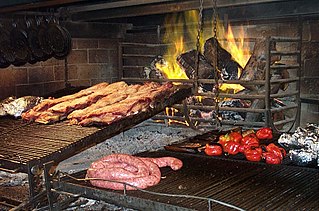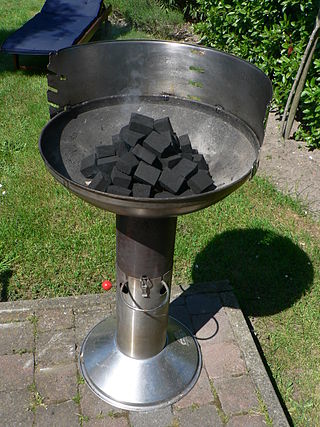
Mexican cuisine consists of the cooking cuisines and traditions of the modern country of Mexico. Its earliest roots lie in Mesoamerican cuisine. Mexican cuisine ingredients and methods begin with the first agricultural communities such as the Olmec and Maya who domesticated maize, created the standard process of nixtamalization, and established their foodways. Successive waves of other Mesoamerican groups brought with them their cooking methods. These included: the Teotihuacanos, Toltec, Huastec, Zapotec, Mixtec, Otomi, Purépecha, Totonac, Mazatec, Mazahua, and Nahua. With the Mexica formation of the multi-ethnic Triple Alliance, culinary foodways became infused.

The cuisine of the American Midwest draws its culinary roots most significantly from the cuisines of Central, Northern and Eastern Europe, and Indigenous cuisine of the Americas, and is influenced by regionally and locally grown foodstuffs and cultural diversity.

Brazilian cuisine is the set of cooking practices and traditions of Brazil, and is characterized by European, Amerindian, African, and Asian influences. It varies greatly by region, reflecting the country's mix of native and immigrant populations, and its continental size as well. This has created a national cuisine marked by the preservation of regional differences.

Asado is the technique and the social event of having or attending a barbecue in various South American countries: especially Argentina, Brazil, Chile, Paraguay, Peru, and Uruguay where it is also a traditional event. An asado usually consists of beef, pork, chicken, chorizo, and morcilla; all of which are cooked using an open fire or a grill, called a parrilla. Usually, red wine and side dishes such as salads accompany the main meats, which are prepared by a designated cook called the asador or parrillero.

A churrascaria is a place where meat is cooked in churrasco style, which translates roughly from the Portuguese word for "barbecue".

Churrasco is the Portuguese and Spanish name for grilled beef prominent in South American and Iberian cuisines, and in particular in Bolivia, Brazil, Uruguay, and Argentina. The term is also used in other Spanish- and Portuguese-speaking countries for a variety of different meat products.

The milanesa is a variation of the Lombard veal Milanese, or the Austrian Wiener schnitzel, where generic types of breaded cutlet preparations are known as a milanesa.

Salvadoran cuisine is a style of cooking derived from the nation of El Salvador. The indigenous foods consist of a mix of Amerindian cuisine from groups such as the Lenca, Pipil, Maya Poqomam, Maya Chʼortiʼ, Alaguilac and Cacaopera peoples and some African influences. Many of the dishes are made with maize (corn). There is also heavy use of pork and seafood. European ingredients were incorporated after the Spanish conquest.

Barbecue varies by the type of meat, sauce, rub, or other flavorings used, the point in barbecuing at which they are added, the role smoke plays, the equipment and fuel used, cooking temperature, and cooking time.

Uruguayan cuisine is a fusion of cuisines from several European countries, especially of Mediterranean foods from Spain, Italy, Portugal and France. Other influences on the cuisine resulted from immigration from countries such as Germany and Scotland. Uruguayan gastronomy is a result of immigration, rather than local Amerindian cuisine, because of late-19th and early 20th century immigration waves of, mostly, Italians. Spanish influences are abundant: desserts like churros, flan, ensaimadas yoo (Catalan sweet bread), and alfajores were all brought from Spain. There are also various kinds of stews known as guisos or estofados, arroces, and fabada. All of the guisos and traditional pucheros (stews) are also of Spanish origin. Uruguayan preparations of fish, such as dried salt cod (bacalao), calamari, and octopus, originate from the Basque and Galician regions, and also Portugal. Due to its strong Italian tradition, all of the famous Italian pasta dishes are present in Uruguay including ravioli, lasagne, tortellini, fettuccine, and the traditional gnocchi. Although the pasta can be served with many sauces, there is one special sauce that was created by Uruguayans. Caruso sauce is a pasta sauce made from double cream, meat, onions, ham and mushrooms. It is very popular with sorrentinos and agnolotti. Additionally, there is Germanic influence in Uruguayan cuisine as well, particularly in sweet dishes. The pastries known as bizcochos are Germanic in origin: croissants, known as medialunas, are the most popular of these, and can be found in two varieties: butter- and lard-based. Also German in origin are the Berlinese known as bolas de fraile, and the rolls called piononos. The Biscochos were re-christened with local names given the difficult German phonology, and usually Uruguayanized by the addition of a dulce de leche filling. Even dishes like chucrut (sauerkraut) have also made it into mainstream Uruguayan dishes.

Mongolian barbecue is a method of preparing stir-fried noodle dishes. Despite its name, the dish is not Mongolian, nor was it influenced by Mongolian cuisine. It was developed in Taiwan by a Chinese expat during the 1950s. Furthermore, it is also unrelated to actual barbecue traditions, since it is not cooked on a perforated grill above the smoke of an open flame, but rather a specialized flatiron grill. It has more in common with Teppanyaki.

Chilean cuisine stems mainly from the combination of traditional Spanish cuisine, Chilean Mapuche culture and local ingredients, with later important influences from other European cuisines, particularly from Germany, the United Kingdom and France. The food tradition and recipes in Chile are notable for the variety of flavours and ingredients, with the country's diverse geography and climate hosting a wide range of agricultural produce, fruits and vegetables. The long coastline and the peoples' relationship with the Pacific Ocean add an immense array of seafood to Chilean cuisine, with the country's waters home to unique species of fish, molluscs, crustaceans and algae, thanks to the oxygen-rich water carried in by the Humboldt Current. Chile is also one of the world's largest producers of wine and many Chilean recipes are enhanced and accompanied by local wines. The confection dulce de leche was invented in Chile and is one of the country's most notable contributions to world cuisine.

Mexican street food, called antojitos, is prepared by street vendors and at small traditional markets in Mexico. Street foods include tacos, tamales, gorditas, quesadillas, empalmes, tostadas, chalupa, elote, tlayudas, cemita, pambazo, empanada, nachos, chilaquiles, fajitas, tortas, even hamburgers and hot dogs, as well as fresh fruits, vegetables, beverages and soups such as menudo, pozole and pancita. Most are available in the morning and the evening, as mid-afternoon is the time for the main formal meal of the day. Mexico has one of the most extensive street food cultures in Latin America, and Forbes named Mexico City as one of the foremost cities in the world in which to eat on the street.

Korean barbecue is a popular method in Korean cuisine of grilling meat, typically beef, pork or chicken. Such dishes are often prepared on gas or charcoal grills built into the dining table itself, though some restaurants provide customers with portable stoves for diners to use at their tables. Alternatively, a chef uses a centrally displayed grill to prepare dishes that are made to order.

Venetian cuisine, from the city of Venice, Italy, or more widely from the region of Veneto, has a centuries-long history and differs significantly from other cuisines of northern Italy, and of neighbouring Austria and of Slavic countries, despite sharing some commonalities.

The cuisine of Chiapas is a style of cooking centered on the Mexican state of the same name. Like the cuisine of rest of the country, it is based on corn with a mix of indigenous and European influences. It distinguishes itself by retaining most of its indigenous heritage, including the use of the chipilín herb in tamales and soups, used nowhere else in Mexico. However, while it does use some chili peppers, including the very hot simojovel, it does not use it as much as other Mexican regional cuisines, preferring slightly sweet seasoning to its main dishes. Large regions of the state are suitable for grazing and the cuisine reflects this with meat, especially beef and the production of cheese. The most important dish is the tamal, with many varieties created through the state as well as dishes such as chanfaina, similar to menudo and sopa de pan. Although it has been promoted by the state of Chiapas for tourism purposes as well as some chefs, it is not as well known as other Mexican cuisine, such as that of neighboring Oaxaca.

Indo cuisine is a fusion cooking and cuisine tradition, mainly existing in Indonesia and the Netherlands, as well as Belgium, South Africa and Suriname. This cuisine characterized of fusion cuisine that consists of original Indonesian cuisine with Eurasian-influences—mainly Dutch, also Portuguese, Spanish, French and British—and vice versa. Nowaday, not only Indo people consume Indo cuisine, but also Indonesians and Dutch people.





















